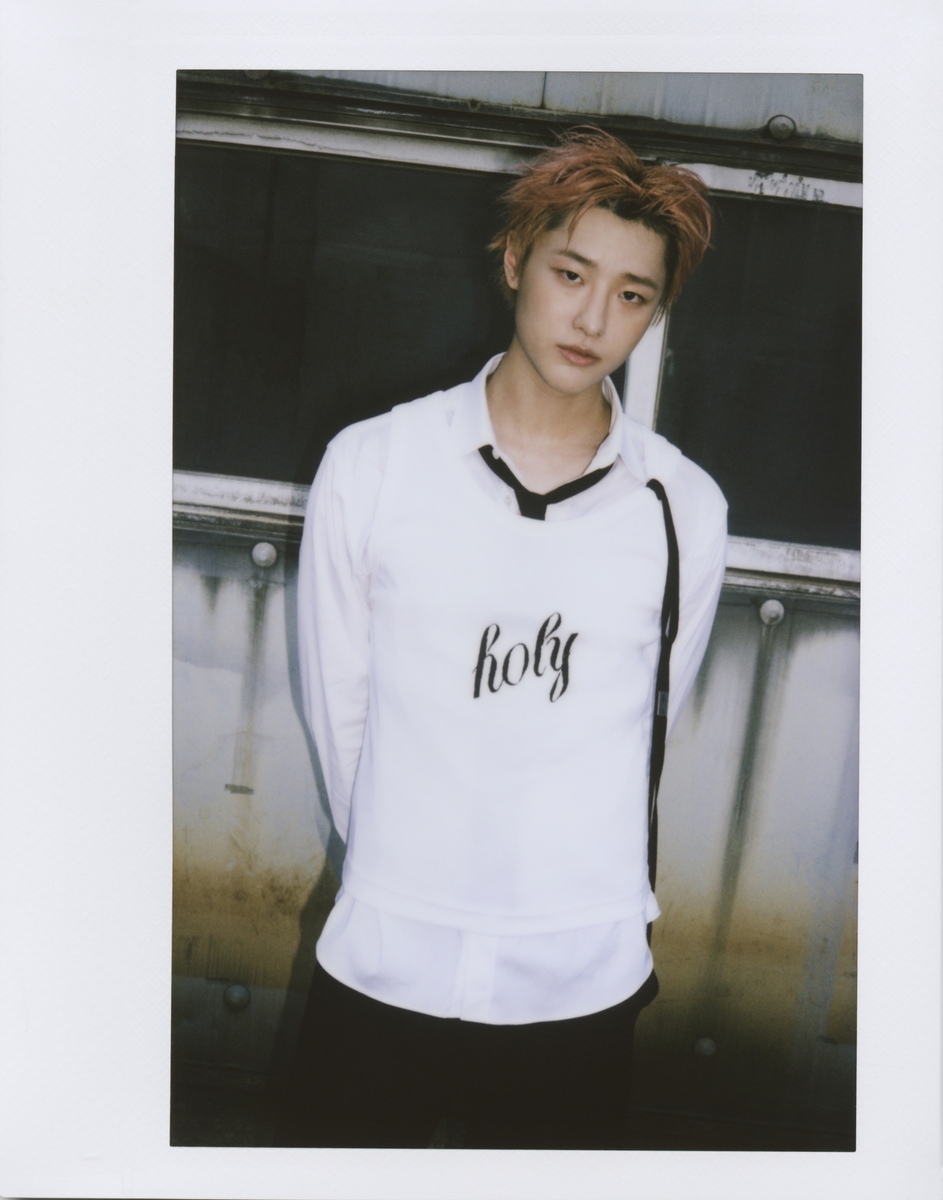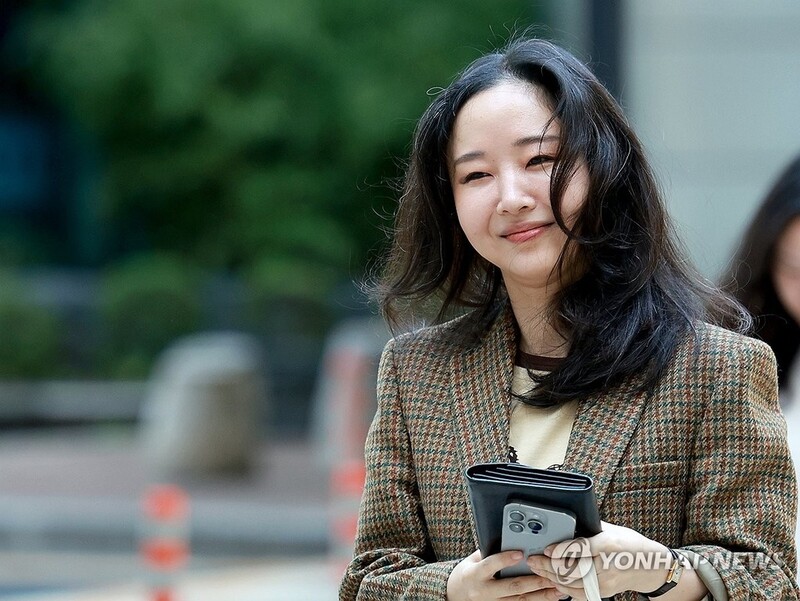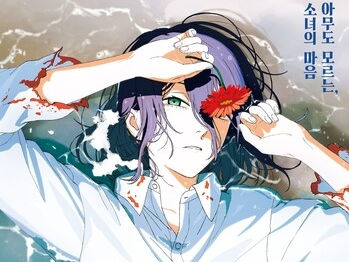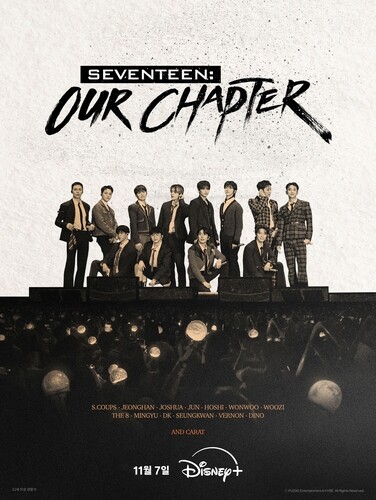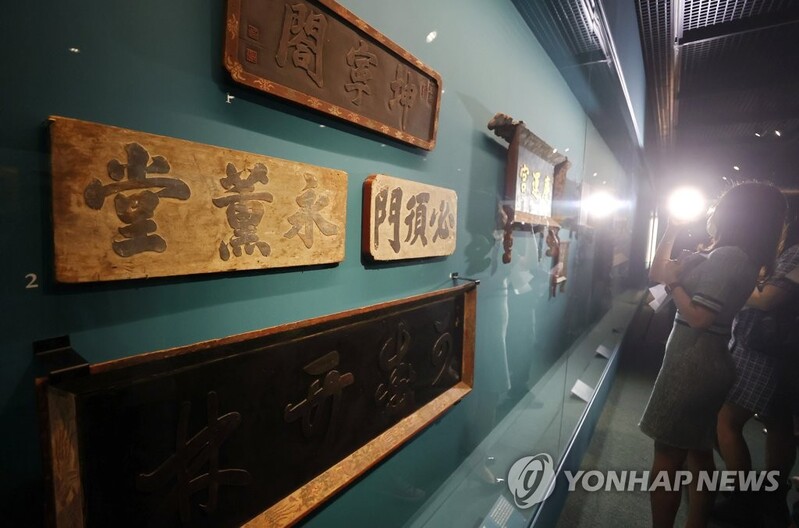 |
| ▲This photo, shows those invited to the exhibition meeting looking around the special exhibition "Hanging Boards Inscribing the Ideals of Joseon" where 83 palace Hanging Boards are in one place. This exhibition, which presents more than 100 pieces of materials including the hanging boards and the related work tools of the Joseon Dynasty, will be held until August 15th. (Yonhap) |
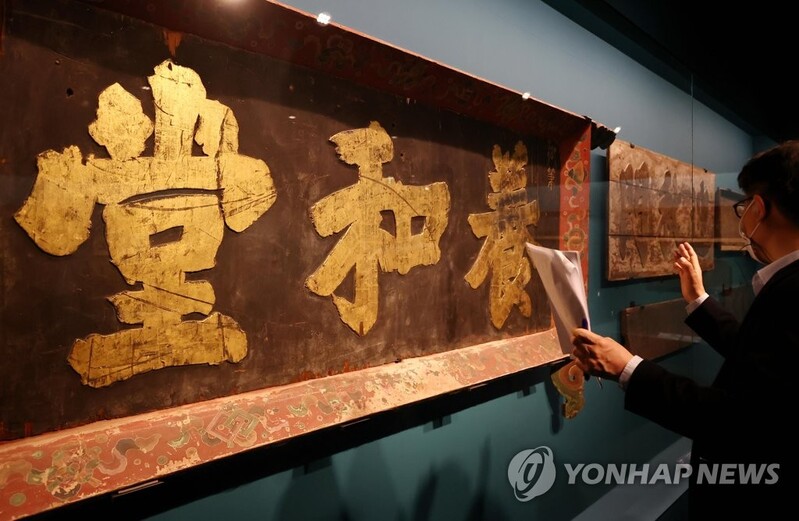 |
| ▲ This photo, shows those invited to the exhibition meeting looking at the hanging board of "Yanghwadang" with the handwriting of Sunjo. This exhibition, which presents more than 100 pieces of materials including the hanging boards and the related work tools of the Joseon Dynasty, will be held until August 15th. (Yonhap) |
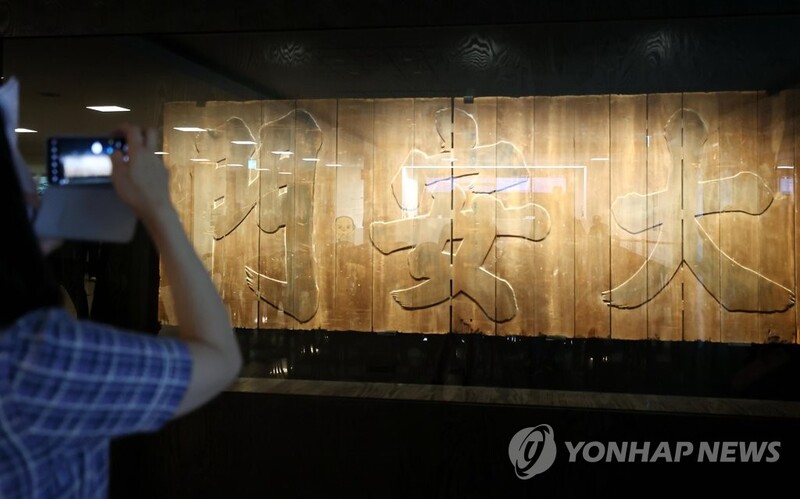 |
| ▲ This photo, shows those invited to the exhibition meeting looking at the hanging board of Daeanmun. This exhibition, which presents more than 100 pieces of materials including the hanging boards and the related work tools of the Joseon Dynasty, will be held until August 15th. (Yonhap) |
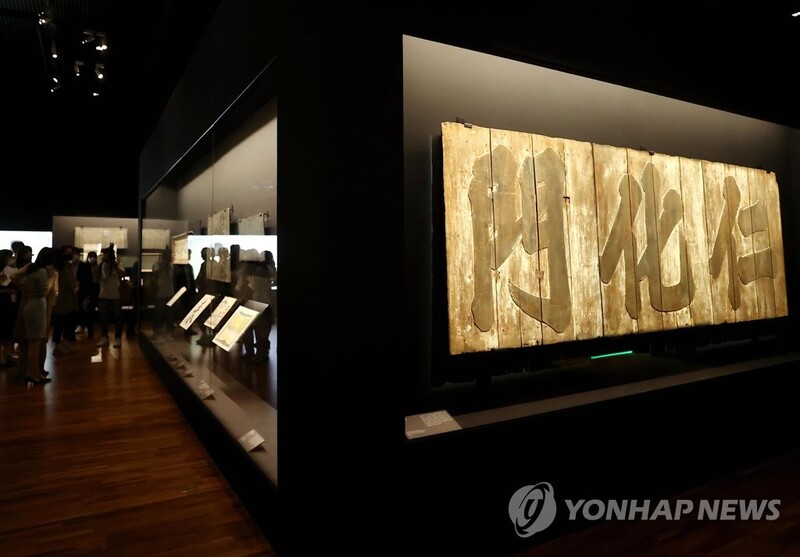 |
| ▲ This photo, shows those invited tot he exhibition meeting looking at the hanging board of "Yanghwadang" with the handwriting of Sunjo. This exhibition, which presents more than 100 pieces of materials including the hanging boards and the related work tools of the Joseon Dynasty, will be held until August 15th. (Yonhap) |
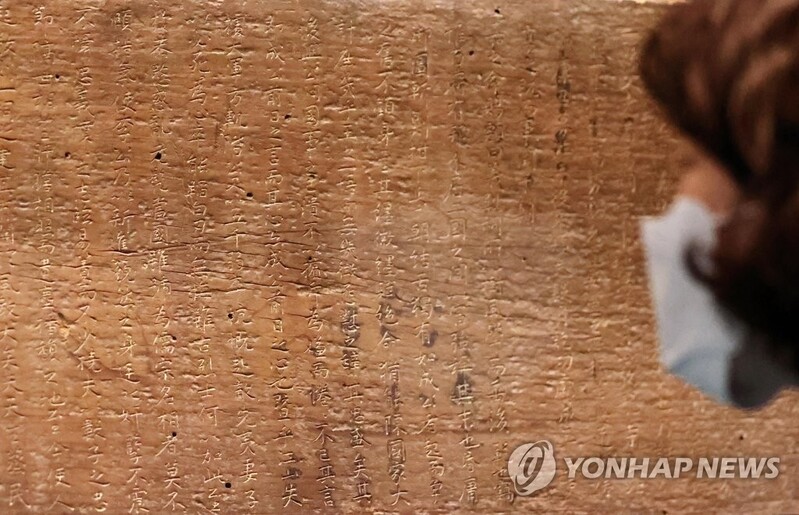 |
| ▲ This photo, shows "Hanging Board with a Record on a Shrine to Patriotic Heroes" written by Han Seok Bong (Han Ho). This exhibition, which presents more than 100 pieces of materials including the hanging boards and the related work tools of the Joseon Dynasty, will be held until August 15th. (Yonhap) |
SEOUL, May 18 (Yonhap) -- During the Joseon Dynasty, Hyeonpan (a hanging board) which was engraved with letters or pictures, served as nameplates indicating the name of a building or as a bulletin board with information.
As the hanging board served the same role as the face of the building, it was carefully crafted. Rather than simply engraving the letters, various patterns were drawn on the edges as well. The hanging board in Guenjeongjeon Hall, the main hall of Gyeongbokgung Palace also has golden letters along with colorful dancheong (refers to Korean traditional decorative colouring on wooden buildings and artifacts for the purpose of style) on the edge of the frame.
Although the hanging board is a compulsory element in the architecture of a palace, it has barely become the main subject in museum exhibitions with only a few pieces being exhibited when it relates to the theme of the exhibition.
An exhibition focusing on the hanging board, which was only treated as a prop, is being held. The National Palace Museum of Korea's special exhibition "Hanging Boards Inscribing the Ideals of Joseon" will be held on the 19th.
Among the 775 signboards owned by the National Palace Museum of Korea, eighty-three were gathered together, including eighty-one royal hanging boards that were inscribed in 2018 on UNESCO’s Memory of the World Register for Asia and the Pacific, along with two hanging boards from the National Museum of Korea. With other related relics including the nationally designated treasure, "Gisa gyecheop (A painting album made in 1719 (the 45th year of the reign of King Sukjong) in commemoration of King Sukjong’s entry into the Giroso (the Office of Elders)" and "Gakjajang (Master artisans who engraved letters or images on wooden boards and otherwise carried out the production of hanging boards) there will be around one-hundred items presented in the exhibition.
The Joseon-era royal hanging boards were mostly damaged during the period of Japanese Colonial Period when the palace buildings were destroyed. Before they became a part of the collection of the National Palace Museum of Korea in 2005, the hanging boards were not settled in a specific place.
"The hanging boards are are of the most valuable relics in terms of quantity and value," Kim In-gyu, the director of the National Palace Museum of Korea, said at an exhibition briefing on the 18th. "This is the first time for a hanging board to be the main subject for a large-scale exhibition."
He continued, "Since most of the hanging boards are written in Chinese, it may seem difficult. However, when one begins to appreciate the various shapes and letters, one will be able to understand the subtle meaning of those words."
The National Palace Museum of Korea, which has been consistently researching on the hanging boards of the Joseon royal family, placed the hanging boards that were hung under the roof at the eye level of an adult. Additionally, "Jeonghwadang," a signboard in a byeolgung (the palace of the new bride queen, also the wife of the heir apparent to the throne) in Anguk-dong will be in the back, where it is difficult for the visitors to see.
"Although this exhibition has academic significance in that it informs the results of research on the hanging board, this exhibition is characterized by the fact that it lowers the height of the signboard so that the visitors will be able to see all the details including the decorations," said Kim Chung-bae, the Director of Exhibition and Public Relations at the National Palace Museum of Korea. "Along with the intangible heritage related to the hanging boards, we also tried to the include the intangible heritage related to its production."
Among the exhibited Hanging Boards, the Hanging Board of Daeanmun (Gate of Great Comfort) is the largest with the size of 374cm in width and 124cm in height. This Hanging Board was made in 1899.
While currently, there is a "Daehanmun" sign hanging at the main gate of Deoksugung palace, in the past, it was called "Daeanmun". This name is told to have been made to hope that the country will have great peace in the midst of the turbulent modern history.
When one goes inside the exhibition hall after looking at the hanging board at Daeanmun, one will be able to see a signboard called "Inhwamun" that is in similar size. Inhwamun was used as the main gate of Deoksugung before Daeanmun. This hanging board measures to 353 cm in width and 122 cm in height. The engraving skills of the hanging boards of both Inhwamun and Daeanmun are very sophisticated.
In the first section, "Making Hanging Boards,” where it presents the calligraphic styles, materials, and production techniques of hanging boards, one will be able to see the "Hanging Board with a Record on a Shrine to Patriotic Heroes" which was written by the noted calligrapher, Han Ho (1543–1605) in 1582.
The "Hanging Board with a Record on a Shrine of Patriotic Heroes," which has a width of 150cm and a height of 36cm is a shrine dedicated to loyal subjects during the reign of King Uija of the Baekje Kingdom and of King Gongmin of the Goryeo Dynasty.
During the Joseon Dynasty, the Hanging Boards were made by Gakjajang (master artisans who engraved letters or images on wooden boards and otherwise carried out the production of hanging boards) and Dancheongjang (craftsman who has inherited Dancheong), while the writings were written by various people, including kings and others including eunuchs. The signboard engraved with the renovation of Daeeunwon in Changdeokgung Palace is a representative relic written by a eunuch.
In the second section, “Embodying Ideals,” it contains four themes, namely “Hanging Boards that Reflect the Duties of a Sage Ruler," "Hanging Boards that Reflect a King’s Affection for His People,” "Hanging Boards that Reflect the Ties between a King and His Subjects” and “Hanging Boards that Reflect Filial Piety."
In the third section, "Hanging Board," 20 hanging boards with various functions are hung on the wall to create a feeling of being overwhelmed for the audience. It is decorated with king’s orders and guidelines for his subjects, the assigned duties and rules for government offices, lists of officials and their tasks, and dates of national event along with signboards that showed the king’s personal feelings or experiences to the public with poems.
Additionally, the exhibition offers diverse media content to enhance the understanding of hanging boards, with a cartoon video that enables one to enjoy the picture "Honghwamun samido" documented in Uigwe (The Royal Protocols of the Joseon Dynasty).
One will also be able to experience writing on the signboard with the background of "Donggwoldo" which realistically depicts Changdeokgung palace and Changgyeonggung palace. The exhibition will be held until August 15th.
(This article is translated from Korean to English by Haemin Kim.)
(END)
(C) Yonhap News Agency. All Rights Reserved











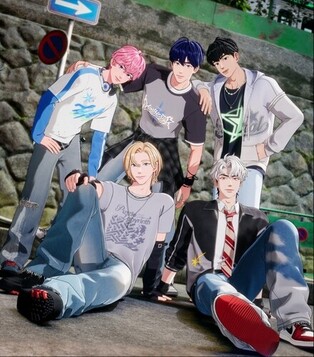

![[가요소식] 보이넥스트도어, 신보로 3연속 밀리언셀러 달성](https://korean-vibe.com/news/data/20251025/yna1065624915905018_166_thum.jpg)
